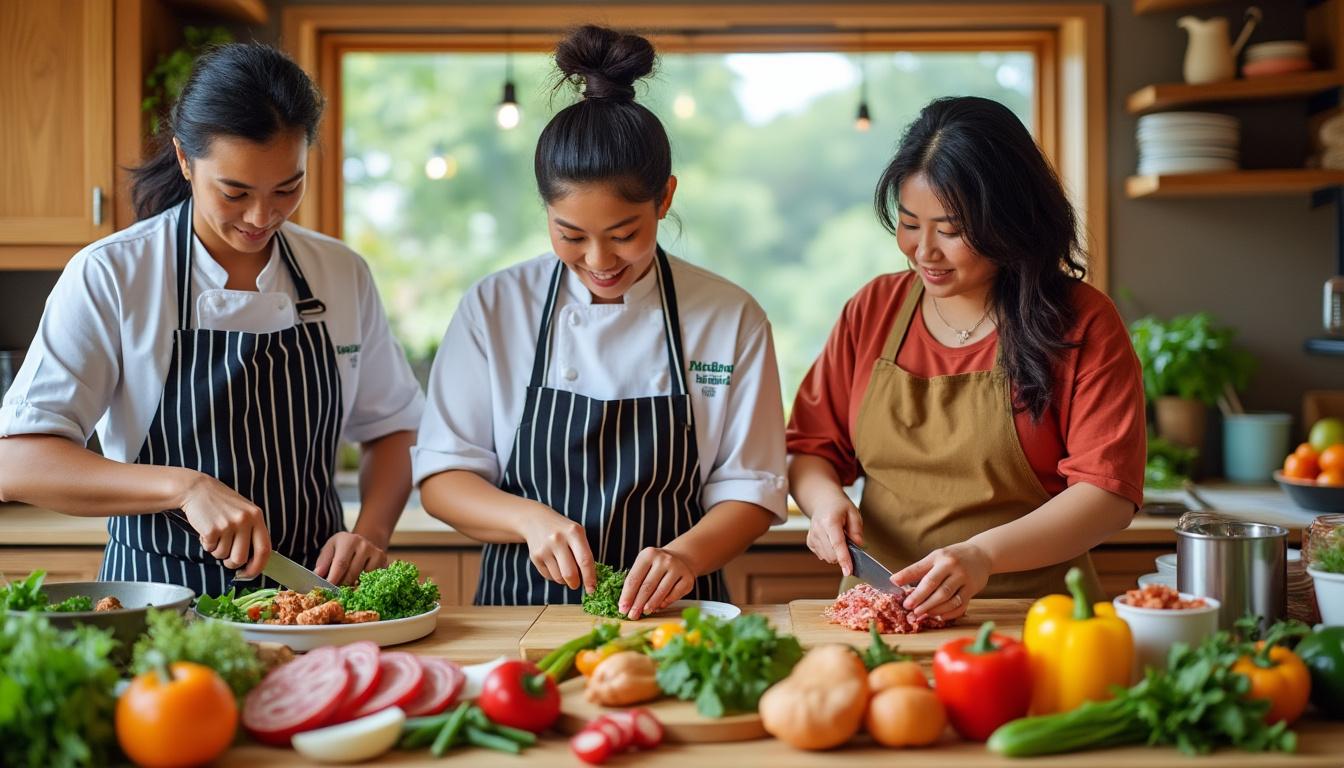Cooking efficiency and flavor mastery are elevated through the wisdom passed down by Asian American and Pacific Islander (AAPI) chefs whose family-rooted approaches have long proven their worth. In celebration of AAPI Heritage Month, chefs across the United States unveil ingenious techniques refined through generations—each hack blending tradition with innovation, all endorsed by the discerning standard of parental approval. Their culinary insights not only maximize ingredient potential and reduce waste but also embody meticulous seasoning, precise preparation methods, and ingenious uses of humble kitchen tools, promising to revolutionize kitchen routines and refine taste profiles for home cooks and professionals alike.
Maximize Ingredient Usage with Resourceful Cooking Tips From AAPI Chefs
Efficient use of every ingredient is a hallmark of heritage cooking traditions, championed by chefs who transform scraps into nourishing dishes, ensuring no flavor is lost. Calvin Eng, recognized as a 2022 Food & Wine Best New Chef and owner of Bonnie’s in Brooklyn, exemplifies this ethos by converting rotisserie chicken carcasses into hearty congee and savoring crispy rice remnants as a snack or infused in rice tea. Such approaches demonstrate that thoughtful kitchen resourcefulness can directly contribute to sustainability, budget-friendly cooking, and enriched culinary experiences.
- Use chicken carcasses and vegetable scraps to create rich, homemade stocks or congee.
- Repurpose crispy rice from pots as a crunchy snack or in infused teas—eliminating waste.
- Seal spice bowls by wiping with cabbage leaves or other greens to conserve all flavors.
- Apply the “Mama Kim” method for juicing—rinsing containers thoroughly to extract every drop of taste.
| Chef | Hack | Benefit |
|---|---|---|
| Calvin Eng | Transform chicken carcasses into congee and use crispy rice creatively | Reduces waste and creates added value dishes |
| Jae Jung | Wipe spice bowls with cabbage leaves to preserve flavor | Maximizes flavor extraction in cooking processes |
Discover additional strategies to store leftovers intelligently and avoid food waste by visiting this comprehensive guide, which offers practical advice for maintaining ingredient integrity and reducing kitchen disposables.
Accelerate Meal Prep and Save Time with Practical Tools and Techniques
Time-saving measures rooted in parental wisdom streamline the cooking process while preserving authentic tastes. Buddha Lo, chef and co-owner of Huso in New York City, advocates the use of a spoon for peeling ginger—an approach lauded for its simplicity and effectiveness even within fine dining contexts. Meanwhile, Heena Patel of Besharam in San Francisco highlights the power of pressure cookers, with her mother’s daily use of multiple sizes providing a blueprint for simultaneous dish preparation that captures depth of flavor without compromising texture or nutritional value.
- Adopt the spoon peeling method for ginger to reduce waste and prepare quickly.
- Utilize varying sizes of pressure cookers for multitasking several dishes efficiently.
- Implement mise en place techniques to organize ingredients methodically before cooking.
- Rely on tested recipes from credible sources like America’s Test Kitchen and Food52 to refine prep steps.
| Tool or Method | Description | Chef Endorsement |
|---|---|---|
| Spoon Peeling for Ginger | Simple tool use that protects delicate root flesh and ecologically smart | Buddha Lo |
| Multiple Pressure Cookers | Cooking various dishes concurrently without loss of quality | Heena Patel |
For effective kitchen hacks that save time and money, the insights shared at this resource offer expanded tips beyond traditional culinary boundaries.
Elevate Flavor Profiles by Mastering Seasoning Techniques Chaperoned by Parental Guidance
Flavor layering and seasoning mastery are fundamental to many celebrated AAPI dishes. These chefs emphasize gradual seasoning, precise balance, and taste testing, skills cultivated through close observation of parental cooking styles. Yoonsoo Park, head chef at NARO in New York City, stresses “season early and taste often,” preventing overuse while encouraging dynamic layering. Devin Fu, preparing to open Dynamo Room, reflects on his father’s advice to temper salt use on canned tomatoes, preserving the natural essence of vegetables.
- Season progressively and taste intermittently to achieve layered complexity.
- Balance acidity, salt, sweetness, bitterness, and umami rather than overloading any element.
- Mix wet and dry seasonings before adding to soups to ensure harmony and depth.
- Use fermented condiments like doenjang and guk-ganjang to enhance broth layers subtly.
| Tip | Technique | Chef |
|---|---|---|
| Season Early and Taste Often | Adjust seasoning continuously throughout cooking | Yoonsoo Park |
| Use Fermented Condiments | Layer complex umami flavors in broths | Changki Kang |
| Balance Sweetness | Counterbalance sweetness with bitterness, salt, nut pastes, and tangy fruit | Seleste Tan & Mogan Anthony |
Home cooks and professionals alike can access insightful seasoning tutorials through platforms such as the Asian Food Network and Bon Appétit, ensuring flavors are vibrant and balanced with expert precision.
Essential Cooking Wisdom Passed Down for Perfect Rice, Soup, and Egg Preparations
Mastering essential staples becomes achievable through intuitive techniques refined in family kitchens. Neel Kajale, chef de cuisine at Adda in New York City, has embraced the “finger method” to measure water-to-rice ratios, eschewing scales and measuring cups for a consistently fluffy outcome. Donny Sirisavath, a 2020 Food & Wine Best New Chef, advises mixing spices separately before introducing them to concentrated soup stocks for intentional flavor layering. Carlo Lamagna’s innovative use of a cornstarch slurry as an egg wash substitute tightens seals on lumpia, enhancing both texture and vegan adaptations.
- Use finger-width water measurement for foolproof rice cooking—no measurement tools needed.
- Combine wet and dry seasonings prior to adding to soups for balanced infusion.
- Substitute traditional egg wash with microwaved cornstarch slurry for better sealing.
- Leverage parental advice for proper breathing techniques during cooking for enhanced focus and calm.
| Technique | Method | Chef |
|---|---|---|
| Finger Method for Rice | Water added to rice to first knuckle on index finger | Neel Kajale |
| Season Soup Post Reduction | Add seasonings after stock reduction for balanced flavor | Donny Sirisavath |
| Cornstarch Slurry Egg Wash | Microwaved slurry as strong adhesive for dumplings | Carlo Lamagna |
More home cooking breakthroughs, including natural remedies for cold and flu and healthy eating on a budget, can be found at Daily Bakersfield News, covering holistic kitchen knowledge beyond mere recipes.
Parental Cooking Traditions Inspire Adaptability and Mindful Practice
The ability to innovate and adapt within culinary frameworks is nurtured by examples of parental ingenuity and care. Chef Eric Valdez of Naks in New York City underscores the value of improvisation when ingredient availability fluctuates, a skill emphasizing creativity without sacrificing cultural integrity. Additionally, a simple but profound practice endorsed by James Lee, owner of 181 Cabrini, involves maintaining deep, consistent breathing to sustain clarity and intentionality during demanding cooking tasks—highlighting the holistic approach to cooking as a physical and mental discipline.
- Embrace improvisation while honoring authentic flavor profiles.
- Adopt mindful breathing techniques to enhance cooking focus and reduce stress.
- Draw inspiration from familial farms and gardens to source fresh herbs and grains.
- Utilize lemons to eliminate odors from hands effectively after handling fish.
| Practice | Details | Chef |
|---|---|---|
| Improvisation in Recipes | Adapting traditional dishes with available ingredients | Eric Valdez |
| Breath Control | Maintaining deep, consistent breathing during cooking for focus | James Lee |
| Lemon for Fish Odor Removal | Rubbing lemon peels on hands to remove fishy smell | Tara Monsod |
For those eager to enhance their culinary repertoire and understand ingredient sourcing with sustainability principles, resources like Blue Apron, HelloFresh, and Eater provide extensive content integrating these parent-approved hacks with modern cooking conveniences and ingredient accessibility.
Frequently Asked Questions About AAPI Chefs’ Cooking Hacks
- How can I extend ingredient usage to reduce kitchen waste?
Utilizing ingredient parts often discarded, such as chicken carcasses for stocks or vegetable roots for soup bases, can tremendously reduce waste while enriching flavor. Techniques like these are emphasized by AAPI chefs and detailed guides like those on Daily Bakersfield News. - What is the benefit of seasoning early and tasting often?
It allows for gradual layering of flavors with dynamic adjustment, preventing over-seasoning and preserving ingredient character, a principle echoed by chefs such as Yoonsoo Park. - Why is the finger method superior to measuring cups for cooking rice?
The finger method adapts intuitively to different pot sizes and quantities, ensuring fluffy and consistent rice every time, as taught by Neel Kajale. - How do fermented condiments enhance soups?
They introduce layers of umami, salinity, and aromatic depth, which balance and enrich broths without overshadowing main ingredients, following lessons from Changki Kang. - What simple kitchen hack removes fish odor from hands?
Rubbing lemon peels on hands after handling fish effectively neutralizes odors, a tradition shared by Chef Tara Monsod.

